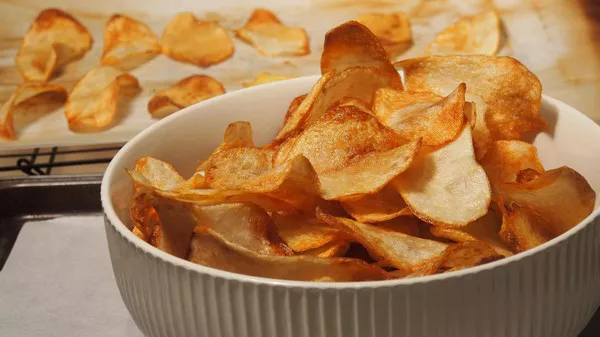Potato chips, with their irresistible crunch and savory flavors, are a popular snack enjoyed by people around the world. However, for individuals living with diabetes, understanding the potential risks associated with potato chips is crucial for managing their condition effectively. Despite being a beloved snack, potato chips can pose challenges for blood sugar control due to their high carbohydrate content, unhealthy fats, and sodium levels. In this article, we delve into the impact of potato chips on diabetes, exploring the risks and providing insights into healthier alternatives. By understanding the nutritional composition and effects of potato chips, individuals with diabetes can make informed choices that align with their dietary needs and promote overall well-being.
The Role of Carbohydrates in Blood Sugar Control
a. Carbohydrate Content of Potato Chips: Potato chips are predominantly made from starchy potatoes, which are high in carbohydrates. A typical serving of potato chips contains a significant amount of carbohydrates, often in the form of rapidly digestible starches.
b. Glycemic Index and Blood Glucose Response: Potato chips have a high glycemic index (GI), meaning they can cause a rapid increase in blood glucose levels after consumption. This can be particularly challenging for individuals with diabetes who need to manage their blood sugar levels.
c. Impact of Portion Size: The portion size of potato chips is often larger than recommended for individuals with diabetes. Consuming a large portion can lead to a significant spike in blood sugar levels.
Unhealthy Fats and Calorie Density
a. Trans Fats and Saturated Fats: Many commercially available potato chips are fried in unhealthy fats, such as trans fats or saturated fats. These fats are associated with an increased risk of heart disease and can negatively impact overall health, particularly for individuals with diabetes who already have an increased risk of cardiovascular complications.
b. Calorie Density: Potato chips are typically high in calories due to the frying process and the addition of flavorings and seasonings. Regular consumption of high-calorie snacks can contribute to weight gain and difficulty in managing blood sugar levels.
Sodium Content and Blood Pressure Concerns
a. Sodium Levels in Potato Chips: Potato chips are notorious for their high sodium content. Excessive sodium intake can contribute to high blood pressure, which is a common comorbidity among individuals with diabetes.
b. Sodium and Fluid Retention: The excessive sodium found in potato chips can lead to fluid retention, which can further contribute to increased blood pressure levels and strain on the cardiovascular system.
Healthier Alternatives to Potato Chips
a. Baked Veggie Chips: Replace traditional potato chips with homemade or store-bought baked vegetable chips. Thinly sliced vegetables such as kale, sweet potatoes, beets, or zucchini can be seasoned and baked for a healthier snack option.
b. Air-Popped Popcorn: Air-popped popcorn, without excessive butter or salt, is a low-calorie and fiber-rich snack alternative. It provides a satisfying crunch and can be flavored with herbs and spices for added taste.
c. Nuts and Seeds: Opt for a handful of unsalted nuts or seeds for a snack that is rich in healthy fats, fiber, and protein. Almonds, walnuts, pistachios, pumpkin seeds, or sunflower seeds are nutritious options that can help curb cravings.
d. Fresh Fruits and Vegetables: Reach for fresh fruits and vegetables, such as apple slices, carrot sticks, or cucumber slices, as a crunchy and nutritious snack. These options provide fiber, vitamins, and minerals without the negative effects of unhealthy fats and excess sodium.
e. Homemade Snack Mixes: Create your own snack mix using a combination of whole-grain cereal, unsalted nuts, seeds, and a small amount of dried fruits. This allows for portion control and customization while providing a balanced snack option.
Mindful Snacking Strategies
a. Portion Control: If you choose to consume potato chips occasionally, practice portion control by measuring out an appropriate serving size. This helps manage carbohydrate intake and minimize blood sugar spikes.
b. Read Food Labels: Pay attention to the nutritional information and ingredient list when purchasing packaged snacks. Look for options that are low in unhealthy fats, sodium, and added sugars.
c. Pairing with Protein or Fiber: To mitigate the impact on blood sugar levels, pair potato chips or any snack high in carbohydrates with a source of protein or fiber. This combination can slow down digestion and help stabilize blood sugar.
d. Planning Ahead: Plan your meals and snacks in advance to avoid impulsive snacking or relying on unhealthy options. Having nutritious alternatives readily available can help prevent reaching for potato chips out of convenience.
Conclusion
Potato chips, while delicious, pose challenges for individuals with diabetes due to their high carbohydrate content, unhealthy fats, and sodium levels. The rapid increase in blood glucose levels, potential adverse effects on heart health, and contribution to weight gain are all concerns that must be addressed. By understanding the impact of potato chips on blood sugar control and overall health, individuals with diabetes can make informed choices that align with their dietary needs.
Exploring healthier alternatives such as baked veggie chips, air-popped popcorn, nuts, seeds, and fresh fruits and vegetables can provide satisfying and nutritious snack options. Practicing portion control, reading food labels, and pairing snacks with protein or fiber are strategies that promote mindful snacking.
Remember, it is essential to consult with a healthcare professional or registered dietitian to personalize your dietary plan and ensure it aligns with your specific needs. By adopting healthier snack alternatives and practicing mindful eating, individuals with diabetes can enjoy a balanced diet while effectively managing their condition.

